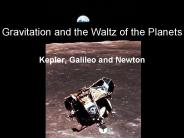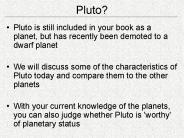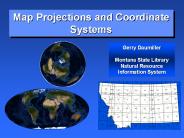Semimajor PowerPoint PPT Presentations
All Time
Recommended
These satellites orbit at an altitude between 700 to 800 km. ... Semimajor Axis: Half the distance between the two points in the orbit that are farthest apart ...
| PowerPoint PPT presentation | free to download
MBHB M1 M2 on a Keplerian orbit with semimajor axis a and eccentricity e ... K is typically positive, but the eccentricity evoution of. the binary is modest ...
| PowerPoint PPT presentation | free to download
Terrestrial planets: Giant impact phase among the isolation-mass bodies: 10-1 1 M ... Body on Keplerian orbit with semimajor axis a, eccentricity e, inclination i ...
| PowerPoint PPT presentation | free to download
These two scientists showed that the Universe was not some ideal perfection as ... 1 AU (astronomical unit) is the semimajor axis of the Earth's orbit. ...
| PowerPoint PPT presentation | free to view
Longitudinal spacing between sequential orbit traces at the equator ... and also -- with another motivation -- semimajor axis increments for CHAMP) To get a copy ...
| PowerPoint PPT presentation | free to view
Today in Precalculus Notes: Conic Sections - Ellipses Homework Go over quiz Ellipses Definition: An ellipse is the set of all points in a plane whose distances from ...
| PowerPoint PPT presentation | free to download
Orbit at Lagrangian Points (60 ahead and behind Jupiter) ... Collisions between asteroids produce smaller fragments (families of asteroids) ...
| PowerPoint PPT presentation | free to download
Using mentor's observations, and own study of Mars, discovers elliptical orbits. ... Suppose that it takes the planet the same amount of time to go between positions ...
| PowerPoint PPT presentation | free to view
Example 1: Example 2: Applications - example The ellipse used to generate the ellipsoid of a Lithotripter has a major axis of 12 ft. and a minor axis of 5 ft.
| PowerPoint PPT presentation | free to download
Orbits of the Planets, Asteroids and Comets. Kepler's 1st Law tells us that. The orbits of the planets are ellipses. with the Sun at one focus. Sun. Perihelion, P ...
| PowerPoint PPT presentation | free to view
Comet SOHO-6. Asteroids, KBOs, Oort Cloud. Asteroid Belt Kuiper Belt Oort Cloud ... Comet Exploration. Exploration Halley Giotto, Vega. Tempel 1 Deep Impact ...
| PowerPoint PPT presentation | free to download
Sir Isaac Newton. From the British One Pound Note. Newton's Ideas. Universal Law of Gravitation: G = 6.67 x 10-11 N m2/kg2. Three Laws of Motion ...
| PowerPoint PPT presentation | free to view
Gather facts. Modify hypothesis Guess an explanation (Guess=hypothesis) Test hypothesis ... If you could observe Earth through a telescope from Mars, Earth would ...
| PowerPoint PPT presentation | free to view
Chapter 14 GRAVITATION 14.1 The World and the Gravitational Force Claudius Ptolemy (A. D. 2nd century) Nicolaus Copernicus (1473 1543) Johannes Kepler (1571 1630)
| PowerPoint PPT presentation | free to view
Title: Long-term Evolution of High Area-to-Mass Ratio Objects in Different Orbital Regions Author: Thomas Schildknecht Last modified by: Thomas Schildknecht
| PowerPoint PPT presentation | free to download
... line between the sun and the planet. A1. A2. KEPLER'S THIRD LAW. T2 ... Planet T a T2/a3. Mercury 0.241 0.387 1.00. Venus 0.615 0.723 1.00. Earth 1.00 1.00 1.00 ...
| PowerPoint PPT presentation | free to download
Satellite Motion. Low Orbit. A container falls off the space station while in ... Testing Models. Geocentric (or Ptolemaic) means the Earth is at the center ... Kepler's Work ...
| PowerPoint PPT presentation | free to view
Gravitation and the Waltz of the Planets Kepler, Galileo and Newton
| PowerPoint PPT presentation | free to download
Title: No Slide Title Author: A.student Last modified by: Cary Epps Created Date: 10/31/2000 3:30:47 PM Document presentation format: On-screen Show (4:3)
| PowerPoint PPT presentation | free to download
Came upon 3 laws of planetary motion. Galileo Galilee: Made his. own telescope and showed ... First Law: Planets orbit in ellipses with the Sun at one focus ...
| PowerPoint PPT presentation | free to view
Universal Gravitation Unit 8 Universal Gravitation Unit 8 Total energy is constant. Total angular momentum is constant. In all isolated gravitationally bound two ...
| PowerPoint PPT presentation | free to download
MODELLING OF EARTH S RADIATION FOR GPS SATELLITE ORBITS Carlos Javier Rodriguez Solano Technische Universit t M nchen carlos.rodriguez@mytum.de
| PowerPoint PPT presentation | free to view
Each planet moves in an elliptical orbit with the sun at one focus. The line connecting the sun to a planet sweeps out equal areas in equal times. ...
| PowerPoint PPT presentation | free to view
... termed perihelion; the point of greatest separation is termed aphelion. A planet moves fastest when it is near perihelion and slowest when it is near aphelion. ...
| PowerPoint PPT presentation | free to view
Chapter 9 & 10 Gravity
| PowerPoint PPT presentation | free to download
Day 4 Chapter 2 Gravitation and the Motion of the Planets Real orbits have the center of mass as one focus For the Sun and planets, this is not a large effect.
| PowerPoint PPT presentation | free to view
HOW to DRAW an ELLIPSE. HOW to DRAW an ELLIPSE. Major Axis. Focus. Focus. Minor Axis ... in motion of a body is proportional to the force acting on it and is ...
| PowerPoint PPT presentation | free to download
What about gravitational forces on the Moon? ... i inclination tilt. P orbital period time. T epoch of periastron a date ... i inclination 0.00001531 deg ...
| PowerPoint PPT presentation | free to download
Pluto? Pluto is still included in your book as a planet, but has recently been demoted to a dwarf planet We will discuss some of the characteristics of Pluto today ...
| PowerPoint PPT presentation | free to download
In this way, the planet can have periods with a transitory ring system. ... Behavior of two particles which collide with the planet in a time less then 100 days. ...
| PowerPoint PPT presentation | free to download
TERPS Conference. Dec. 9, 2004. Background. Formation of Jupiter and Saturn in our Solar System. Gradual accumulation of planetesimals into cores followed by ...
| PowerPoint PPT presentation | free to download
UNIVERSAL LAW OF GRAVITATION There is a popular story that Newton was sitting under an apple tree, an apple fell on his head, and he suddenly thought of the Universal ...
| PowerPoint PPT presentation | free to view
COBE near-infrared image of the Milky Way. NGC 891. Magellanic clouds. Fornax dwarf galaxy. Leo I dwarf galaxy. M31 = Andromeda galaxy NGC 205 M32 ...
| PowerPoint PPT presentation | free to view
1st- and 2nd-order continuum near Fe XII. 2nd-order continuum near C II ... Example: oblate spheroid with a tidal bulge. Example: brightening around secondary minimum? ...
| PowerPoint PPT presentation | free to download
... Mars: ~5 gm/cm3 Jupiter, Saturn, Uranus, Neptune: ~1 gm/cm3 Reference ... Christine Lavin References Much more information on Pluto is ...
| PowerPoint PPT presentation | free to download
A. Sesana1, F. Haardt1, P. Madau2 The Final Parsec: Orbital Decay of Massive Black Holes in Galactic Stellar Cusps 1 Universita` dell'Insubria, via Valleggio 11 ...
| PowerPoint PPT presentation | free to download
Distance between sun and planet varies (perihelion-closest; aphelion-farthest) ... aphelion, slowest; perihelion, fastest. Sense of a force from sun acting on ...
| PowerPoint PPT presentation | free to view
Planetesimals outside the snow line became eccentric ... Density of solids: divide mass of region by total N, or fix planetesimal mass at 0.01M ...
| PowerPoint PPT presentation | free to download
Kepler's 1st Law: A planet orbits the Sun in an ellipse, with the Sun at on ... Astronomical unit [AU], average distance between Earth and Sun: 1 AU = 1.496 108 ...
| PowerPoint PPT presentation | free to view
TheNewAstronomy.ppt The New Astronomy Nicholas Copernicus (1473 - 1543) Accounted for problems with calendar by introducing (re-introducing) the heliocentric ...
| PowerPoint PPT presentation | free to view
Unique in that it appears to have undergone volcanism Two other Asteroids to know Pallas 580 km and Juno 540 km Asteroid Observations The Galileo space ...
| PowerPoint PPT presentation | free to view
Janus and Epimetheus (Saturn) swap orbits every 4 years ... Hyperion rotation in Saturn-Titan tug-of-war ... Saturn's Rings. 300,000 km wide X 10 m (!) thick ...
| PowerPoint PPT presentation | free to view
Developed by National Imagery and Mapping Agency (NIMA, formerly Defense Mapping ... National Geographic's 'Round Earth, Flat Map' ...
| PowerPoint PPT presentation | free to download
12.540 Principles of the Global Positioning System Lecture 05 Prof. Thomas Herring Room 54-611; 253-5941 tah@mit.edu http://geoweb.mit.edu/~tah/12.540
| PowerPoint PPT presentation | free to download
Dance of the Planets Planetary motion. Tycho Brahe and his observations ... Orbits of planets are ellipses with the Sun at one focus ...
| PowerPoint PPT presentation | free to view
Accretion of Planets Bill Hartmann Star & Planet Formation Minicourse, U of T Astronomy Dept. Lecture 5 - Ed Thommes Overview Start with planetesimals: km-size bodies ...
| PowerPoint PPT presentation | free to download
Newton s law of universal gravitation Liz Fox 2-16-06 A little review Law 1: The orbit of a planet/comet about the Sun is an ellipse with the Sun's center of ...
| PowerPoint PPT presentation | free to download
Title: Anal za dat v GIS Author: Jan Wild Last modified by: Jan Wild Created Date: 12/3/2003 1:49:13 PM Document presentation format: P edv d n na obrazovce
| PowerPoint PPT presentation | free to download
A projectile is any object that is projected by some means and ... Kinetic energy is greatest, speed is hight. Perihelion, aphelion, apply to planet and Sun ...
| PowerPoint PPT presentation | free to view
ASEN 5050 SPACEFLIGHT DYNAMICS Two-Body Motion Prof. Jeffrey S. Parker University of Colorado Boulder Lecture 3: The Two Body Problem *
| PowerPoint PPT presentation | free to view
Halliday/Resnick/Walker Fundamentals of Physics 8th edition Classroom Response System Questions Chapter 13 Gravitation Reading Quiz Questions 13.7.1.
| PowerPoint PPT presentation | free to view
Physics 111: Elementary Mechanics Lecture 12
| PowerPoint PPT presentation | free to view
... studies but allows one to cover large parameter space Generalizes Heggie s perturbation analysis for distant hyperbolic ... integrals with asymptotic ...
| PowerPoint PPT presentation | free to download
Chapter 13 Reading assignment: Chapter 14.1-14.4 Homework : (due Monday, Oct 31, 2005): Problems: Q5, Q10, 1, 3, 7, 12, 20, Kepler s first two laws (1609): Planets ...
| PowerPoint PPT presentation | free to download
The Hertzsprung-Russell Diagram Hertzsprung and Russell had the idea of plotting the luminosity of a star against its spectral type. This works best for a cluster ...
| PowerPoint PPT presentation | free to download
Johannes Kepler was born in Weil der Stadt in Swabia, in southwest Germany in 1571. ... today graduate seminars did he acquaint his students, among whom was Kepler, ...
| PowerPoint PPT presentation | free to view
























































